Episodes

Wednesday Nov 11, 2020
Wednesday Nov 11, 2020
This week, we share Part 1 of a “crowd sourced” episode recorded as a webinar with listener feedback we call “Talking with Tech Live”! To start, Chris and Rachel cover some AAC core concepts, like criteria for evidence-based practice, signs a child needs AAC, avoiding “quick fire” phrases, and 80/20 ratio for core words. Then, Rachel and Chris, together with listeners, discuss some effective coaching strategies when working with AAC users via telepractice! Stay tuned next week for more listener questions & participation in Part 2!
Before the interview, Chris and Rachel talk about connecting with people who share similar genetic information, including the story of how Chris learned he had a half-brother through 23 and Me!
Key ideas this week:
🔑 Three criteria ASHA about evidence-based practice: Is there research supporting the practice? Do professionals agree it’s a good strategy? What are people who actually use AAC telling us works for them?
🔑 Signs a child needs AAC: If they aren’t able to speak, they have minimal language, speech is hard to understand, vocabulary less than 50 words, or they use a high level of scripted phrases.
🔑 Be careful of using “quick fire” stored phrases. They can be useful for certain circumstances, like social situations, but quick fires don’t support the individual building blocks of language very well.
🔑 Talk with AAC users about things that are memorable, exciting, interesting, even gross. AAC users aren’t inspired to talk about boring things any more than anyone else would be!
Want more great TWT content and with access to members-only resources? Support our podcast at patreon.com/talkingwithtech!
Visit talkingwithtech.org to access previous episodes, resources, and CEU credits that you can earn for listening to TWT episodes!
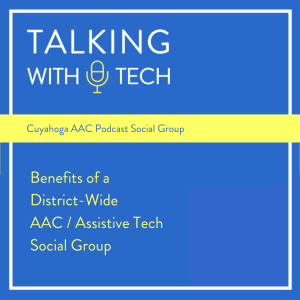
Wednesday Nov 04, 2020
Wednesday Nov 04, 2020
This week, TWT presents Rachel and Chris’s meet-up with an AAC social group of SLPs and AT specialists in Cuyahoga county in Ohio! Their AAC podcast & research group sets aside time every month to listen and discuss a TWT podcast episode or journal article via Zoom. Rachel and Chris dropped by to connect with them and learn about how they have used the podcast to further AAC in their district. The social group talks about how they formed their group, how Zoom has helped make getting together easier, how helpful learning about AT can be for SLPs, and creating social groups for AAC users within the district!
Before the interview, Chris and Rachel brainstorm assistive technology questions that listeners might have, and some possible answers. For example, turning on closed captions is really helpful with building literacy by presenting information in multiple modalities. Rachel and Chris also discuss word prediction and when a student might benefit from prediction that is “in line” rather than “ahead”.
Key ideas this week:
🔑 Meeting on Zoom makes people more willing to participate in learning groups like this. Hopefully teleconferencing can make professional development for everyone more organic, authentic, and fun.
🔑 You can use Zoom to help students connect via a social group. This can be for just AAC users, AAC users and people who don’t use AAC, or even as a mentor-type relationship between a more advanced user and an emerging AAC user.
🔑 A social group for AAC users, whether in person or on Zoom, develops vocabulary that users may not use as often in an academic setting , like greetings and humor.
Help us develop new content and keep the podcast going strong! Support our podcast at patreon.com/talkingwithtech!
Visit talkingwithtech.org to access previous episodes, resources, and CEU credits that you can earn for listening to TWT episodes!
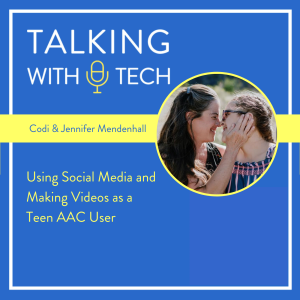
Wednesday Oct 28, 2020
Wednesday Oct 28, 2020
This week, TWT presents Chris and Rachel’s interview with Codi Mendenhall, a 14-year-old who has been using AAC since she was 5, and her mother Jennifer Mendenhall. Jennifer and Codi recently shared their story on a TEDx talk - you can watch here. Codi and Jennifer share about Codi’s journey learning to use AAC, the ways that Codi uses texting and social media to communicate with her peers, how to facilitate more communication opportunities for AAC users, and more!
Before the interview, Rachel and Chris discuss some of their upcoming trainings on coaching and virtual AAC assessment. Chris shares about a recent multi-series event he hosted with both live and asynchronous components, and how the pandemic has made new ways of learning possible.
Key ideas this week:
🔑 When selecting AAC, it’s important to consider the input of those who will be communicating most with the AAC user, e.g., the family may find one app easier to program and use than others.
🔑 Communication partners need to be very patient with AAC users and should try hard not to finish their sentences for them.
🔑 One way we can help motivate AAC users is by demonstrating that AAC is a way to connect more closely with the people in their life.
Check out Codi’s YouTube Channel, Codi’s Life
Help us develop new content and keep the podcast going strong! Support our podcast at patreon.com/talkingwithtech!
Visit talkingwithtech.org to access previous episodes, resources, and CEU credits that you can earn for listening to TWT episodes!
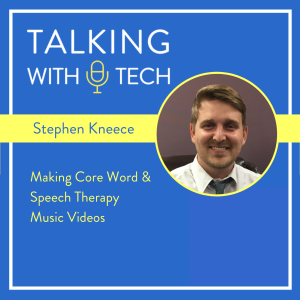
Thursday Oct 22, 2020
Thursday Oct 22, 2020
This week, TWT presents Chris’s interview with SLP, AT Specialist, and founder of Speech and Language Songs, Stephen Kneece! During the interview, Chris and Stephen discuss his work as a professor teaching AAC, as President-Elect of SCSHA, and how he founded a Youtube channel playing his original songs, including many songs targeting core words.
Before the interview, Rachel and Chris talk about how they are promoting AAC during AAC Awareness Month. Check out Chris’s Inclusive Technology Spotlight here: http://bit.ly/lcpsaac. Rachel also shares about the new packet of resources she created to help learn more about an AAC user’s vocabulary needs (find out more at rachelmadel.com). Finally, Rachel and Chris discuss their hope that we all can continue to coach families via Zoom after SLPs are back working in person.
Key ideas this week:
🔑 Coaching parents and team members has been more important than ever during COVID. Hopefully after COVID is less of a concern we can continue to reach out and coach an AAC user’s circle of support as part of our normal practice.
🔑 We can often get more bang for our buck helping families and staff support an AAC user than only working with the AAC user one-on-one.
🔑 Steven is the creator of Speech and Language Songs, a great resource with lots of songs about language concepts and using core words. You can learn more at https://speechandlanguagesongs.com
Help us develop new content and keep the podcast going strong! Support our podcast at patreon.com/talkingwithtech!
Visit talkingwithtech.org to access previous episodes, resources, and CEU credits that you can earn for listening to TWT episodes!
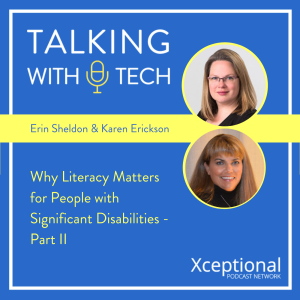
Thursday Oct 15, 2020
Thursday Oct 15, 2020
This week, we share Part II of Erin Sheldon’s interview with Karen Erickson! In this fascinating second half, Erin and Karen talk about emergent vs conventional literacy, and four indicators that maximize the likelihood of success with conventional literacy instruction (e.g., phonics, decoding, spelling):
Does this child know most of the letters most of the time?
Does the child have a means of communication and interaction?
Are they interested and engaged during shared reading (when not given a reinforcer)?
Is there an understanding that writing is about letters and words?
Erin and Karen also discuss the benefits of inclusion for everyone in the classroom, and why Project Core is a universal, Tier 1 solution for teaching symbol-based communication.
Before the interview, Rachel and Chris discuss one of Rachel’s clients whose family had no idea that the client had the ability to read and write. Rachel and Chris talk about the importance of doing foundational assessments to see what clients know, why incorporating books into therapy is so important, and the benefits of bringing in a reading specialist. They also touch upon dealing with a family who feels guilt that they did not understand how to help their child sooner.
Key ideas this week:
🔑 It’s important to let your client pick what to read in therapy. If we are to develop a love for reading, it’s better with a book that interests them. Epic books is one way to search for interesting books (and it's free for educators).
🔑 If we say a student “isn’t ready yet” for high-tech AAC, there needs to be a plan for how we will get there. If we only provide low-tech supports with no core words, there may be no pathway to robust AAC.
🔑 If we are trialing a device with someone who has never learned core words, we can’t expect them to use their device right away. If we teach core words to everyone with complex communication needs with or without a device, they are better prepared to use a device at a later point.
Help us develop new content and keep the podcast going strong! Support our podcast at patreon.com/talkingwithtech!
Visit talkingwithtech.org to access previous episodes, resources, and CEU credits that you can earn for listening to TWT episodes!
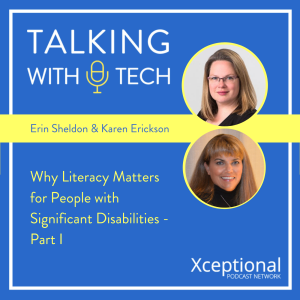
Wednesday Oct 07, 2020
Wednesday Oct 07, 2020
This week, TWT presents part 1 of special education specialist Erin Sheldon’s amazing interview with literacy expert Dr. Karen Erickson on promoting literacy for people with significant disabilities, including deaf/blindness and severe intellectual disability. They talk about supporting access to grade level standards for kids with complex needs, the problem of the candidacy model, why literacy is critical for everyone's well being, and more!
Before the interview, Rachel shares about meeting Hannah Foley virtually and how Rachel was able to connect Hannah with one of her clients. She shares about all of the ways that meeting a proficient AAC user motivated her client (and her client’s circle of support) to work even harder to achieve AAC proficiency.
Key ideas this week:
🔑 We can teach reading and writing every day to every person. It’s not easy and it may take longer, but it isn’t impossible. There are people with significant disabilities that read and write every day.
🔑 Without literacy, a person with significant disabilities may lose the ability to connect with friends who have moved away after school. We want people to be engaged and happy when they are 25, not just when they are 10. Literacy is the way that we socially connect now.
🔑 “Presume competence” doesn’t mean “presume there is no disability”. We don’t want to presume people with significant disabilities will learn the same way in the same amount of time. We should presume potential and that there is a path to success.
Help us develop new content and keep the podcast going strong! Support our podcast at patreon.com/talkingwithtech!
Visit talkingwithtech.org to access previous episodes, resources, and CEU credits that you can earn for listening to TWT episodes!
Smiles for Speech provides children with special needs living in impoverished communities with the therapeutic intervention and resources they need to enhance their ability to reach their full potential. Contact them at sfsvirtual@smilesforspeech.org to sign up for their upcoming dyslexia workshop on October 10th!
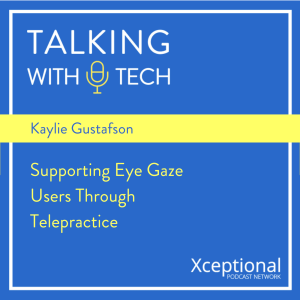
Wednesday Sep 30, 2020
Wednesday Sep 30, 2020
This week, Rachel interviews Kaylie Gustafson, an SLP and AAC specialist in the schools who frequently works with AAC users who utilize eye tracking. Kaylie talks about remote modeling over Zoom using the “remote control” feature, which allows her to model on the user’s device and watch what the user does in response. Kaylie shares lots of tips and tricks for supporting eye gaze, including turning on visual/auditory selection feedback, using Boom Cards and Google Slides with eye gaze, positioning and calibration during telepractice, and more!
Before the interview, Chris and Rachel talk about their recent presentation,“Talking With Tech Live.” During TWTL, they answered questions along with the participants and “crowdshared” the presentation, allowing the community to help each other learn! Rachel and Chris share their thoughts about this format and promise to air segments from this presentation in upcoming episodes of TWT!
Key ideas this episode:
🔑 You can model on an AAC user’s iPad during telepractice by using the “remote control” feature on Zoom. Learn more here.
🔑 Help Kidz Learn is membership service with lots of activities and games for a variety of access methods, including switch, eye gaze, mouse, and touch.
🔑 Ian Bean’s SENict Resources page has an excellent (free!) selection of online activities for switch, touch screen, mouse, and eye gaze that can be used in therapy and assessments.
More Links:
Access to Education conference
Gassy Gary Powerpoint on TpT
Assistive Touch
How to Annotate in Zoom
Toy Theatre
Crickweb
Playlists on Rachel's YouTube Channel
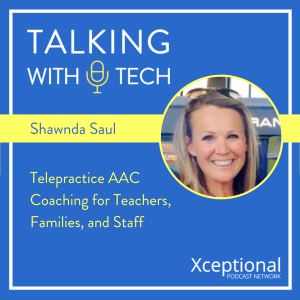
Wednesday Sep 23, 2020
Wednesday Sep 23, 2020
This week, Chris interviews Shawnda Saul, an SLP and AAC Specialist who runs the Learning Language AAC Initiative for Arlington Public Schools. Chris and Shawnda discuss how she promotes modeling and language instruction in the classroom, her approach to coaching communication partners, the changes she has seen coaching families during distance learning, and more!
Before the interview, Chris and Rachel talk about rethinking how we educate students. Teaching is still thought of as presenting information to a class from the front of the classroom and having students spit that information back on a test. For example, math instruction often has students memorize formulas and complete worksheets, even if they have dyscalculia. Chris demonstrates how we can better ground learning in functional problems, like discussing planting lettuce as a way to understand the concept of perimeters.
Key ideas this week:
🔑 Accurate content about the world is widely available to students, making the concept of a teacher providing information to students from the front of a classroom less relevant. Instead, we should be teaching students strategies for absorbing and evaluating content more effectively on their own.
🔑 Coaching communication partners about AAC and making them I feel comfortable using a device is the most important thing clinicians supporting AAC can do.
🔑 For many SLPs during distance learning, a much bigger part of therapy with AAC users takes place in the home. Hopefully we can continue to reach out to families to support them after school resumes in-person and move to more of a coaching model rater than just direct therapy.
Help us develop new content and keep the podcast going strong! Support our podcast at patreon.com/talkingwithtech!
Visit talkingwithtech.org to access previous episodes, resources, and CEU credits that you can earn for listening to TWT episodes!
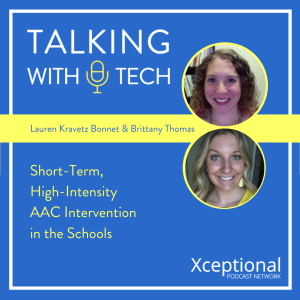
Wednesday Sep 16, 2020
Wednesday Sep 16, 2020
This week on TWT, we share Chris’s interview with Lauren Kravetz Bonnet, an SLP & AT Specialist, and Brittany Thomas, who is also an SLP. Lauren and Brittany talk about their school-based communication program to support students with complex communication needs. This program is a short-term (i.e., less than two years), high-intensity intervention to teach young students to use their device more effectively. It is not a self-contained program; students get their support in an integrated, general education setting with in-class speech support for a large portion of the day. Lauren and Brittany share about their success with this program, the reduced need for this program as teachers embrace AAC more broadly, the importance of reflective listening with teachers and families, lessons learned training peers to become communication partners, and more!
Before the interview, Rachel and Chris discuss one of Rachel’s new adult clients and the bittersweet experience of seeing the potential in the client but also seeing the time that was lost to poor AAC implementation. Rachel’s client uses some sign language and has had a device for many years, but he arrived without many skills using the device. The device was difficult to navigate and was not optimized for motor planning, and parents said that when they started using the device “he didn’t want to use it.” Rachel shares about the many great signs that AAC will be successful, including that the client pays a lot of attention to communication and is a quick learner. Finally, Rachel shares about the changes she has made to his device template and how she has improved implementation at home.
Key ideas this week include:
🔑 Building rapport with school staff is a big part of Brittany and Lauren’s success. When teachers see that the device isn’t a barrier to progress in the classroom and the AT team is there to support them, they are more likely to embrace the device in the classroom.
🔑 Lauren started having much greater success with teachers and staff by doing more job-embedded coaching and reflective listening to lead people to their own solutions rather than telling them what to do. This leads to greater motivation on the part of staff and less of a struggle to find success.
🔑 Getting school peers to engage in authentic communication with AAC users increases positive attitudes about AAC and can be really motivating to all the students involved.
Follow Lauren @aps_astech and Brittany @msbrittanyslp on Twitter to learn more about them and their awesome work!
Help us develop new content and keep the podcast going strong! Support our podcast at patreon.com/talkingwithtech!
Visit talkingwithtech.org to access previous episodes, resources, and CEU credits that you can earn for listening to TWT episodes!
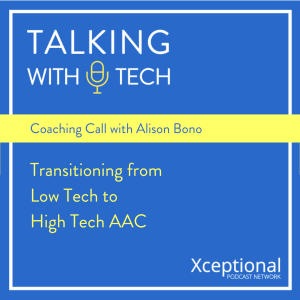
Wednesday Sep 09, 2020
Wednesday Sep 09, 2020
This week, TWT shares Rachel and Chris’s coaching call with Alison Bono! Alison is an SLP who reached out to Rachel and Chris for help working with a young student with complex communication needs. On the call, Rachel and Chris explore moving from low-tech to high-tech supports, getting teachers on board with a core language approach, integrating core words into routines, motivating the circle of support, and more!
Before the coaching session, Rachel and Chris dive into Rachel’s latest “intensive” approach to supporting clients. During this approach, Rachel had observation and coaching sessions at least once a day over a two week period with a client’s circle of support, including behavior therapists, occupational therapists, speech therapists, and parents. Rachel shares how this intensive approach gave her a new perspective on this client, provided lots of ideas for making faster progress, and gave everyone even more motivation to support the client’s use of AAC and language.
Key ideas this week:
🔑 Until Rachel observed the whole circle of support during intensive coaching, she wasn’t aware of everything that was happening with communication partners. Partners may not see that they are prompting, or that the client is not actually responding spontaneously.
🔑 Asking reflective questions can be more helpful than giving advice. Allowing people to think through their problems and come up with their own solutions can lead to greater ownership and change.
🔑 A more intensive approach harnesses the collective energy of the team and promote greater change. Positive change in the client can then motivate the circle of support to continue improving and growing.
Help us develop new content and keep the podcast going strong! Support our podcast at patreon.com/talkingwithtech!
Visit talkingwithtech.org to access previous episodes, resources, and CEU credits that you can earn for listening to TWT episodes!
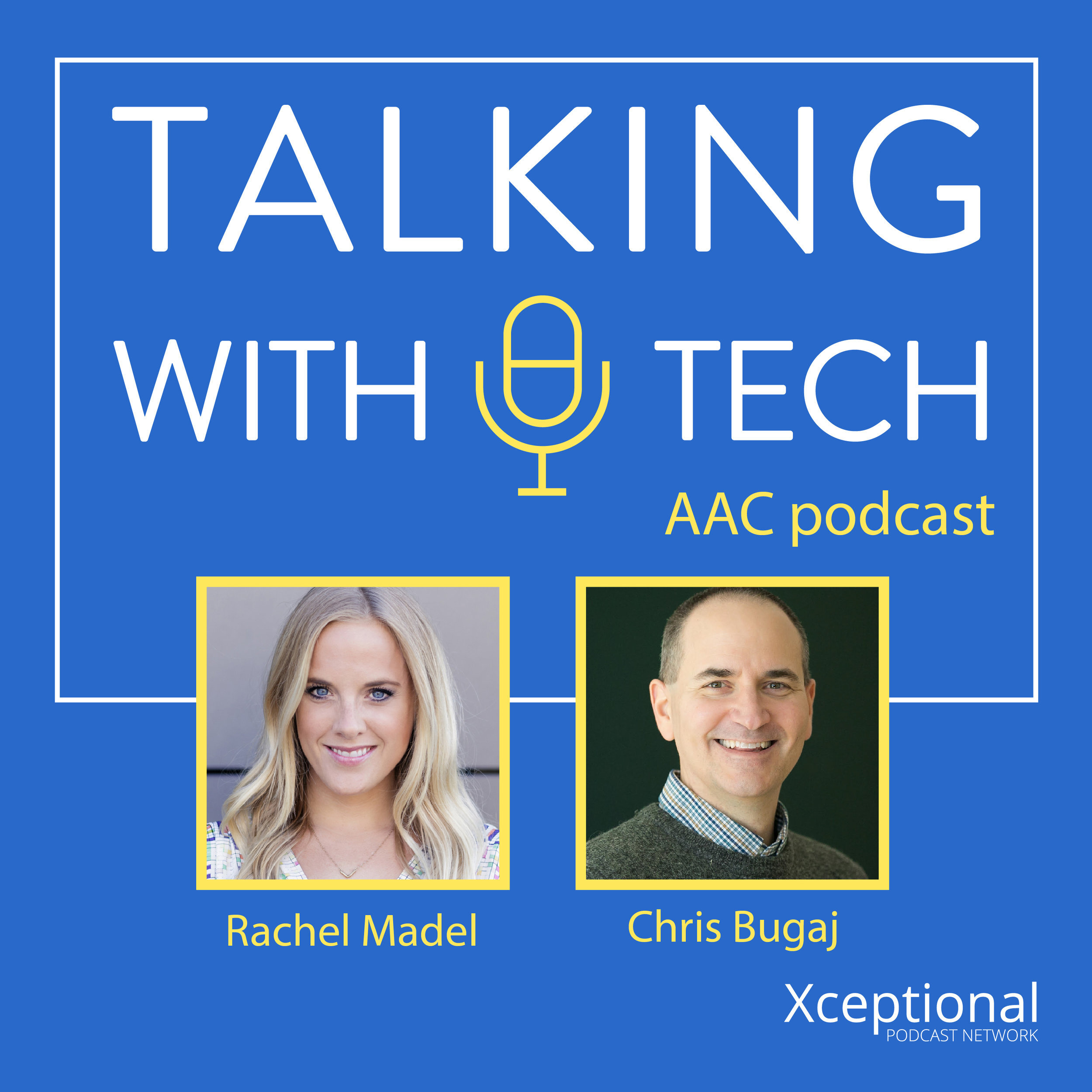
Join AAC experts Rachel Madel and Chris Bugaj as they dive into a weekly discussion about all things AAC (Augmentative and Alternative Communication). Every episode they deliver practical resources, clinical guidelines and relevant research to help clinicians better utilize technology for individuals with complex communication needs.
Episodes include interviews with industry thought-leaders, clinicians, parents, researchers and app developers to keep you on the pulse of the educational technology scene and better support communication through the use of technology.


